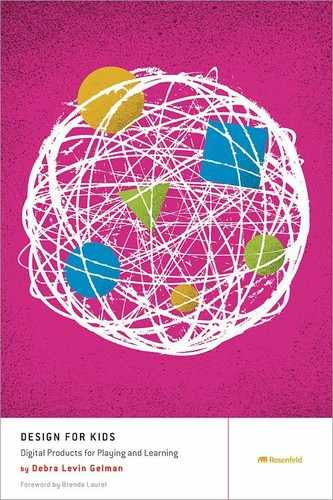FOREWORD
As a parent as well as a researcher and designer of interactive media for over 30 years, I have found the world of digital design for kids fraught with condescension, oversimplification, and downright sloppiness. Children, because they are not adults, have seemed not to require elegant and thoughtful design. According to many developers, designing for kids must somehow be easier because kids are simpler than adults, aren’t they? All you need is a good property license like Superman or ET (as the old Atari would have it), and you’re good to go.
Debra Levin Gelman has done a great service for kids in the digital world by writing this thoughtful, thorough, example-filled book for the designers of digital games and apps for children. The text itself is remarkably well informed and communicated in a straightforward manner. By including a huge variety of examples with screen shots and excellent critiques, Gelman shows as well as tells. Her case studies and interviews also enrich the reading, and they demonstrate that Gelman knows her subject thoroughly and first-hand. Each chapter addresses a particular two-year age range, tracking developmental and social features of the age group and providing a concise set of design heuristics. A final chapter on design research with children gives designers methods for reaching out to their audiences and “absorbing,” as Gelman puts it, their mind-sets and preferences.
Throughout the book, specific insights caught my eye—sometimes because they matched my own experiences so well, and sometimes because they took me by surprise. In the 2 to 4 age range, for example, I was surprised and pleased to see Gelman’s painstaking analysis of the successful use of visual indicators to communicate hierarchy and focus. Her examples of parents’ frustrations with their kids repeating actions that would lead to certain kinds of noises were illuminating for me (although it did not change my long-held belief that things that make loud, repetitive noises are toys from hell and should probably be taken into the driveway and run over). In the 4–6 age group, I was delighted by Gelman’s observation that “sometimes, making something feel social is as easy as presenting it in the first person.” Having conducted many years of research on relationships between gender, technology, and play, I resonated deeply with her heuristic that the designer’s response to gender should be guided by how kids play rather than who we think they are.
I am fondest of the observations and heuristics that have to do with how design may nurture the delicate development of what we may later call “critical thinking skills.” For example, marking the distinction between advertising and content when a child is just beginning to be able to recognize the difference can help kids develop into adults with informed criticality of media and messaging. One of my favorites of Gelman’s bits of advice is that we make younger kids’ experiences of “losing” or “being wrong” more interesting. The notion of an interesting failure can lead to the kinds of criticality and bravery that make for resilient, creative adults. These qualities among others are fostered by application of Gelman’s insights about design.
Although the book is crisp and clear-eyed about its subject, it reveals Gelman’s love and respect for persons of a tender age. I hope that everyone who designs interactive stuff for kids will read it and take it to heart.
Brenda Laurel
Santa Cruz Mountains, California
